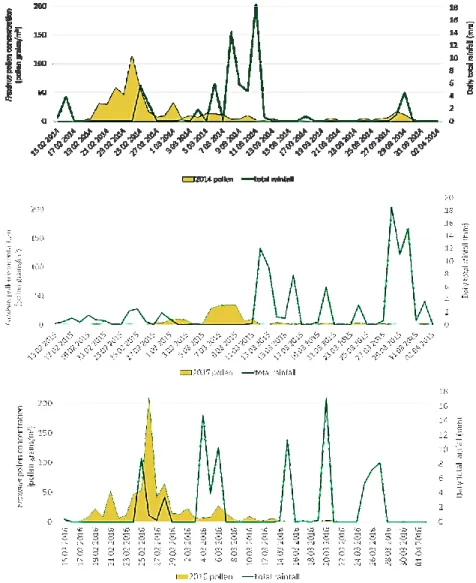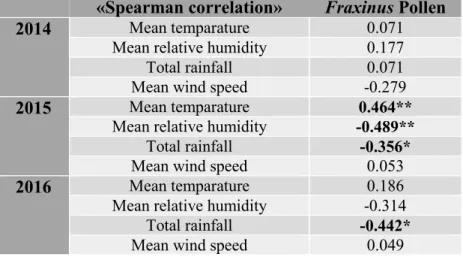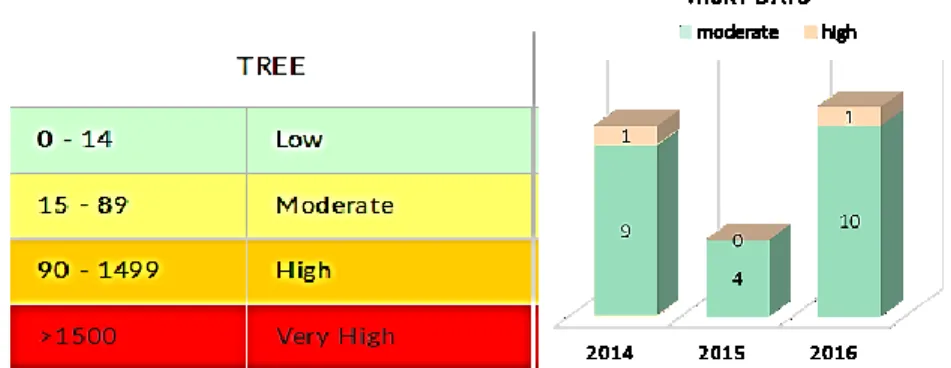Volume 27, Number 2, Pages 141-149 (2018) DOI: 10.1501/commuc_0000000209 ISSN 1303-6025 E-ISSN 2651-3749
http://communications.science.ankara.edu.tr/index.php?series=C
Received by the editors: November 06, 2018; Accepted: November 26, 2018. Key word and phrases: Chestnut honey, chemical analysis, antioxidant activity
Submitted via II. Aerobiology and Palynology Symposium 07-10 October 2018 (APAS 2018)
© 2018 Ankara University Communications Faculty of Sciences University of Ankara Series C: Biology FRAXINUS L. POLLEN DYNAMICS IN ANKARA ATMOSPHERE
AYDAN ACAR SAHIN, NUR MUNEVVER PINAR
Abstract. Fraxinus L. (Ash) is a deciduous wind-pollinated tree of the Oleaceae family widely extended intemperate zones of the North and Central Europe. In general, Ash trees are one of the most frequent natural species of riversides, forests, nonetheless, they are also commonly used as ornamental plants in parks and gardens of urban areas in Europe and Turkey as well. It is not clear whether ash pollen is a primary cause of sensitization or whether it is implied through cross-sensitization of other Oleaceae pollen. In aerobiological studies, Fraxinus pollen was the secondly dominant pollen types after Cupressaceae pollen during early spring. The aim of this study was to analyze Fraxinus airborne pollen dynamics in Ankara, describe their pollen season and effects of meteorological parameters on them. A 7-day volumetric trap, running continuously throughout the year, was used to collect circulating pollen and aerobiological sampling was carried out three years (2014-2016). Fraxinus pollen was counted as grains/m3 and the main pollen season was deduced from these data. Correlations with climatic factors (temperature, rainfall, humidity, wind speed) impacts on pollen were assessed by Spearman’s rank correlation test. Risky days for allergic individuals were determined due to the AAAAI classification. Fraxinus pollen were observed from the second part of February to the end of the March during three years. The pollen seasons pattern was found quite similar and the peak days were in the last week of February in 2014 (523 pollen grains/m3) and 2016 (669 pollen grains/m3). However in 2015, the pollen concentrations was quite lower (204 pollen grains/m3) and the peak day was later than the other years. While the pollen levels of Fraxinus were positively correlated with mean daily temperature (99% probability), they were negatively correlated relative humidity (95% probability) and the total rainfall in 2015. The days number with moderate level, which have more than 15 pollen grains, were found higher in 2014 and 2016. Also, only one day was found with high level risky for both 2014 and 2016 years. However, there were only four days were observed with the moderate level risky in 2015.
1. Introduction
Fraxinus (Ash) is a deciduous wind-pollinated tree of the Oleaceae family widely
extended intemperate zones of the North and Central Europe. In general, Ash trees are one of the most frequent natural species of riversides, forests, nonetheless, they are also commonly used as ornamental plants in parks and gardens of urban areas in Europe and Turkey as well. Fraxinus, has 65 species, the majority of which are spread in the temperate regions of the Northern hemisphere [1]. It is distributed in Central and Northern regions in Europe [2]. There are four species that are naturally distributed in Turkey as follow: F. ornus L., F. excelsior L., F. angustifolia Vahl. and F. pallisae Wilmott. In our country, the most widespread ash tree is F.
angustifolia species. Ash tree shows widespread in almost all coastal areas in
Turkey, Thrace Eastern and Western Black Sea Region, Marmara, Aegean, Mediterranean, in Eastern and also in Southeastern Anatolia Region [3]. Some of the species found in our country are important forest trees and most of them are decorative ornamental plants [4].
It is not clear whether ash pollen is a primary cause of sensitization or whether it is implied through cross-sensitization of other Oleaceae pollen (as in the Mediterranean–temperate areas) or botanically unrelated plants, such as grasses and birch, due to the presence of pollen panallergens, such as profilins and polcalcins. Cross-reactivity between the major allergens (Ole e 1, Fra e 1) of these 2 trees is important, reaching 85%-95% due to the considerable amino-acid sequence identity and immunologic cross-reactivity [5, 6]. Most of the studies, published until now about Oleaceae pollen allergy, used extracts for olive, much less extracts for ash and very few privet extracts. In the study conducted in Spain, it was reported that there was no difference between Olea L., Fraxinus, Ligustrum L. and Syringia L. pollen in skin prick tests and histamine release tests and it was reported that Olea europaea L. pollen should be used in the detection and treatment of susceptibility to Oleaceae pollen grains [2]. Olea-sensitized individuals who have symptoms even in areas where there are no olive trees, and it has been suggested that, this is due to the cross reaction of another pollen from the member of the Oleaceae family (such as
Fraxinus). In the region of Anatolia, a part of the country without olive trees, but
with important ash forests nearby; two studies realised in Ankara and Eskişehir have indicated a degree of sensitization to Olea pollen of 60% for Ankara and 22% for Eskisehir [7]. Similarly, in a small study which showed 14 positive skin tests to Ole e 1, Fra e 1, Lig v 1 and Syr v 1 from 15 olive - monosensitized patients. Patients with suspected pollen allergy living in
Ankara and central Anatolia should be analyzed with a panel of allergens including pollen with high allergenicity and/or high/very high concentrations including Poaceae, Chenopodiaceae/Amaranthaceae, Asteraceae, Cupressaceae, Quercus L.,
Fraxinus, Fagus L., Oleaceae, Platanus L., Poaceae, Populus L. and Salix L. [8]. Fraxinus pollen was the third airborne pollen in terms of relevance [4], showing that
the start of pollination occurs at the end of the year in Turkey. In aerobiological studies, Fraxinus pollen was the secondly dominant pollen types, which compose in average 2.5% of the total pollen concentration, after Cupressaceae pollen during early spring in Ankara province [9]. The majority of olive-positive allergic reactions during the early spring in Ankara can be caused by Fraxinus instead of Olea. The aim of this study was to analyze Fraxinus airborne pollen dynamics in Ankara, describe their pollen season and effects of meteorological parameters on them.
2. Materials And Methods 1.1. Site information
Ankara is situated in the Inner Anatolian region of Turkey at an altitude 1.093 meters, at 39°57’ N, 32°53’ E. The small part of the North of the province is situated in the Black Sea region of Turkey. The province is part of the Irano-Turanian, Euro-Siberian and Mediterranean floristic regions. The main flora of province is steppe vegetation which is nurtured by the arid and semiarid aspects of the Mediterranean climate, which is a dry sub-humid climate with little or no water surplus.
1.2. Aeropalynological survey
Airborne pollen measurements were carried out using a Burkard volumetric 7-day spore trap in Ankara, during the pollen season from January to December during 2014 to 2016. The trap was placed on the roof of the building (F block) in Tandoğan campus of Ankara University at a height of 30 m above ground level. All pollen
counts were converted into daily average concentrations (grains/m3) referred in REA
(The Spanish Aerobiology Network). The level of allergenicity of pollen grains from these identified taxa was classified according to information found in literature [10, 11].
1.3. Meteorological data
Daily and monthly mean meteorological data (mean daily temperature, relative humidity, rainfall and wind speed) were obtained from the Turkish State Meteorological Service located at Ankara (2014-2016).
1.4. Statistics analysis
Spearman’s correlation analysis was used to compare the meteorological factors and the pollen concentrations during three years. All calculations were carried out in IBM SPSS Statistics V21. Also, the risky days for allergic individuals were determined due to the American Academy of Asthma Allergy and Immunology’s classification.
3. Results And Discussion
During the pollen season Fraxinus, the average temperatures were 8.45 ºC, 5.62 ºC, 8.67 ºC respectively in 2014, 2015 and 2016. The rainy days number before the season was found higher in 2015 than the other years. All characteristics for the pollen seasons were given in Table 1.
TABLE 1. Seasonal pollen dynamics in Ankara during three years.
Pollen Peak value (grains/m3) Peak date of pollen level Seasonal sum of pollen (grains/m3) Pollination period (98% method) Number of rainy days between 15-28th Feb 2014 113 24th Feb 527 38 4 2015 34 8th March 204 29 9 2016 210 26th Feb 669 27 5
Fraxinus pollen were observed from the second part of February to the end of the
March during three years. The pollen seasons pattern was found quite similar and
the peak days were in the last week of February in 2014 (523 pollen grains/m3) and
2016 (669 pollen grains/m3). The highest pollen concentration and the peak value
(Table 1, Figure 1). The date of the peak values of Fraxinus pollen in both years (2014 and 2016) were recorded between 24-26th February.
In aerobiological studies, Fraxinus pollen were detected in the spring months in our country. The main pollen load was observed in Samsun and Sakarya in February, Bitlis, Rize, Edirne, Usak, Balikesir-Savastepe, in March, Eskisehir-Sivrihisar, Bartin, Mugla-Fethiye, Mugla-Koycegiz, Bursa, Kastamonu and Istanbul in April [12]. Fraxinus pollen concentrations in the ambient air of Ankara has been fluctuating over the years [8, 9, 13]. Ceter et al. [14] examined atmospheric pollen concentrations of Kastamonu province between 2006-2007 years. The percentages of Fraxinus pollen amount was found 0.1% in 2006, while it was detected as 0.3% in 2007.
TABLE 2. Spearman’s rank correlation coefficients between aerobiological and meteorological parameters (*p<0.05, **p<0.01, two tailed).
«Spearman correlation»
Fraxinus Pollen
2014
Mean temparature 0.071Mean relative humidity 0.177
Total rainfall 0.071
Mean wind speed -0.279
2015
Mean temparature 0.464**Mean relative humidity -0.489**
Total rainfall -0.356*
Mean wind speed 0.053
2016
Mean temparature 0.186Mean relative humidity -0.314
Total rainfall -0.442*
Mean wind speed 0.049
No statistically significant correlation between Fraxinus pollen concentrations and the meteorological factors was recorded in 2014. However in 2015, the pollen
concentrations was quite lower (204 pollen grains/m3) almost half of the previous
year and the peak day was later than the other years. While the pollen levels of
Fraxinus were positively correlated with mean daily temperature (99% probability),
they were negatively correlated with relative humidity (99% probability) and the total rainfall (95% probability) in 2015 (Table 2). Unlike 2014, in 2015 the main season started at the end of the February. The continuous rainfall and the lower temperatures could be the reason of the lower pollen concentration in 2015. But rainy days could be important of allergic sufferers as it could cause of
the allergens releasing. Although, it was observed more or less same amount of the total rainfall between 15-28th February, there was an evident difference in the number of rainy days among the years.
FIGURE 2. Risky days for Fraxinus pollen allergy based on AAAAI classification.
The study conducted by Kasprzyk et al. [15] in seven cities in Poland shows that the start of the Fraxinus season occurs in the first 10 days of April. In our study, the seasons were found a month earlier than Poland because of the Mediterranean floristic region characteristics. In a study which is about Fraxinus pollen analysis and forecast models based on meteorological factors, the data showed that weather conditions mainly in February were important factors to the Fraxinus pollen season. It was also reported that the rainfall in the second 10 days of January, humidity in the first 10 days of February, and the mean temperature in the second 10 days of February, largely determined Fraxinus pollen season duration [16]. In our study, the rainfall and the humidity in the second 10 days of February mainly determined the onset and duration of the season.
In addition, we tried to determine the possible risky days for Fraxinus allergy by using the threshold values of AAAAI. The number of the risky days with moderate level, which have more than 15 pollen grains, were found higher in 2014 and 2016. Also, only one day was found with high level risky for both 2014 and 2016 years. However, there were only four days were observed with the moderate level risky in 2015 (Figure 2). As a conclusion, our results revealed that not only amount of rainfall but also the number of rainy days could be effective on Fraxinus pollen emissions.
References
[1] H. Kayacık, Orman ve park ağaçlarının ozel sistematiği. I.U. Yayını, No 3013,
Istanbul, 3, (1982).
[2] M.J. Pajarón, L. Vila, I. Prieto, A. Resano, M.L. Sanz and A.K. Oehling,
Cross-reactivity of Olea europaea with other Oleaceae species in allergic rhinitis and bronchial asthma. Allergy, 52(8), (1997) 829–835.
[3] A. Guner, Türkiye bitkileri listesi (Damarlı bitkiler). Nezahat Gokyıgıt
Botanik Bahçesi ve Flora Araştırmaları Dernegi Yayını, Istanbul, (2012)
[4] A. Bicakci, A. Tosunoglu, M.K. Altunoglu, G. Saatcioglu, A.M. Keser, and
F. Ozgokce, An aeropalynological survey in the city of Van, a high altitudinal region, East Anatolia-Turkey. Aerobiologia, 33(1), (2017) 93–108.
[5] V. Niederberger, A. Purohit, J.P. Oster, S. Spitzauer, R. Valenta and G. Pauli,
The allergen profile of ash (Fraxinus excelsior) pollen: cross‐reactivity with allergens from various plant species. Clinical & Experimental Allergy, 32(6), (2002) 933–941.
[6] W. Hemmer, M. Focke, F. Wantke, M. Gotz, R. Jarisch and S. Jäger, Ash
(Fraxinus excelsior) pollen allergy in central Europe: specific role of pollen panallergens and the major allergen of ash pollen, Fra e 1. Allergy, 55(10), (2000) 923–930.
[7] A.B. Dursun, G.E. Celik, S. Alan, N.M. Pinar, D. Mungan and Z. Misirligil,
Regional pollen load: effect on sensitisation and clinical presentation of seasonal allergic rhinitis in patients living in Ankara, Turkey. Allergologia et
Immunopathologia (Madr.), 36(6), (2008) 371–378.
[8] I. Kizilpinar, E. Civelek, A. Tuncer, C. Dogan, E. Karabulut, U.M. Sahiner,
S.T. Yavuz and C. Sackesen, Pollen counts and their relationship to meteorological factors in Ankara, Turkey during 2005–2008. International
Journal of Biometeorology, 55(4), (2011) 623–631.
[9 O. Inceoglu, N.M. Pinar, N. Sakiyan and K. Sorkun, Airborne pollen
concentration in Ankara, Turkey 1990–1993. Grana, 33(3), (1994) 158–161. [10] G. D’Amato, L. Cecchi, S. Bonini, C. Nunes, I. Annesi-Maesano, H.
Behrendt, G. Liccardi, T. Popov and P. Van Cauwenberge, Allergenic pollen and pollen allergy in Europe. Allergy, 62(9), (2007) 976–990.
[11] A.B. Sin, N.M. Pınar, Z. Mısırlıgil, T. Ceter, A. Yıldız and S. Alan, Polen Allerjisi (Türkiye Allerjik Bitkilerine Genel Bir Bakış). Engin Yayınevi, Ankara (2007).
[12] A. Bicakci, M. K. Altunoglu, A. Tosunoglu, S. Celenk, Y. Canitez, H. Malyer and N. Sapan, Türkiye’de Oleaceae familyasına ait allerjenik Olea (Zeytin agacı) ve Fraxinus (Disbudak agacı) polenlerinin havadaki dağılımları.
Asthma Allergy and Immunology, 7, (2009) 133–146.
[13] N.M. Pinar, N. Sakiyan, O. Inceoglu and A. Kaplan, A one-year aeropalynological study at Ankara, Turkey. Aerobiologia, 15(4), (1999) 307-310.
[14] T. Ceter, N.M. Pinar, K. Guney, A. Yildiz, B. Asci and M. Smith, A 2-year aeropalynological survey of allergenic pollen in the atmosphere of Kastamonu, Turkey. Aerobiologia, 28(3), (2012) 355-366.
[15] I. Kasprzyk, A. Uruska, K. Szczepanek, M. Latałowa, J. Gaweł, K. Harmata, D. Myszkowska, A. Stach and D. Stępalska, Regional differentiation in the dynamics of the pollen seasons of Alnus, Corylus and Fraxinus in Poland (preliminary results). Aerobiologia, 20 (2), (2004) 141–151.
[16]. A. Kubik-Komar, K. Piotrowska-Weryszko, E. Weryszko-Chmielewska and B. M. Kaszewski, Analysis of Fraxinus pollen seasons and forecast models based on meteorological factors. Annals of Agricultural and Environmental
Medicine, 25(2), (2018) 285–291.
Current Address: AYDAN ACAR SAHIN: Ankara University, Science Faculty, Biology Department, 06100, Tandoğan, Ankara, Turkey.
E-mail : aydanacar24@gmail.com
ORCID: https://orcid.org/0000-0002-5350-5534
Current Address: NUR MUNEVVER PINAR: Ankara University, Science Faculty, Biology Department, 06100, Tandoğan, Ankara, Turkey.
E-mail: pinar@science.edu.tr



